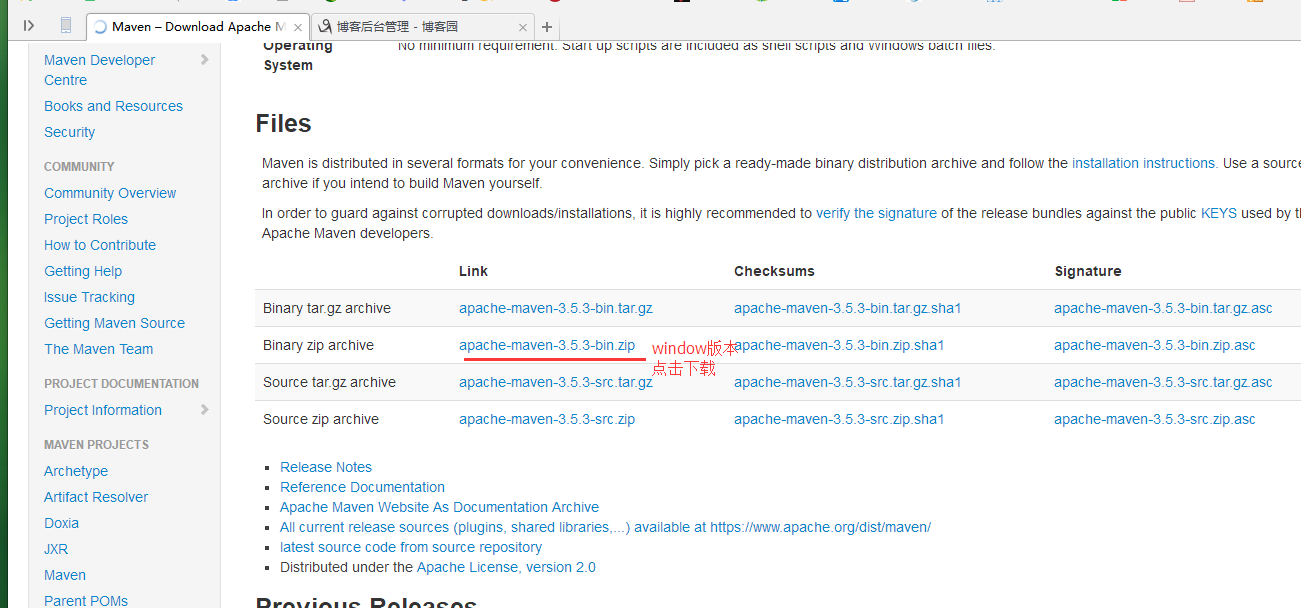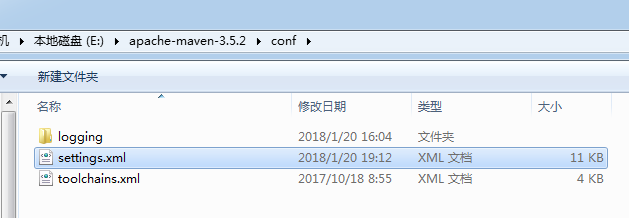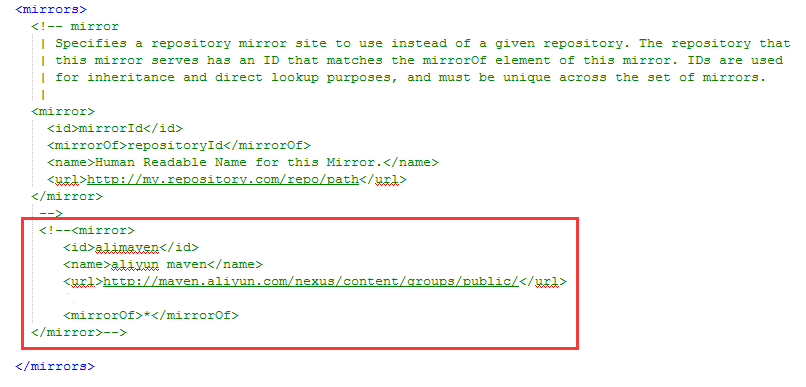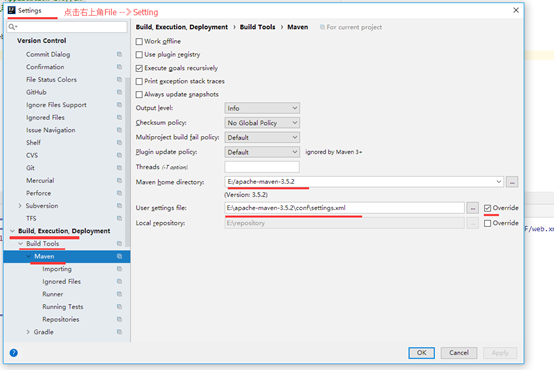Maven下载 || 配置本地仓库 || IntelliJ IDEA配置Maven教程
本文章主要介绍1.Maven下载 2.配置本地仓库Repository 3.IDEA配置Maven 三点。
相关博客:
Eclipse配置Maven https://www.cnblogs.com/hero123/p/9076260.html
ItelliJ IDEA下载及获取注册码详解 https://www.cnblogs.com/hero123/p/9092178.html
IntelliJ IDEA创建Maven+SSM+Tomcat+Git项目【全程详解】https://www.cnblogs.com/hero123/p/9092576.html
首先下载Maven :
Maven官网下载地址:http://maven.apache.org/download.cgi ,下载后解压:

其次配置Maven中的setting 文件:
1/找到刚才解压Maven文件,然后找到/conf/settings.xml

2/修改配置文件中的本地仓库路径,和远程仓库路径(我配置的是阿里镜像仓库,jar包下载速度快)
- <?xml version="1.0" encoding="UTF-8"?>
- <!--
- Licensed to the Apache Software Foundation (ASF) under one
- or more contributor license agreements. See the NOTICE file
- distributed with this work for additional information
- regarding copyright ownership. The ASF licenses this file
- to you under the Apache License, Version 2.0 (the
- "License"); you may not use this file except in compliance
- with the License. You may obtain a copy of the License at
- http://www.apache.org/licenses/LICENSE-2.0
- Unless required by applicable law or agreed to in writing,
- software distributed under the License is distributed on an
- "AS IS" BASIS, WITHOUT WARRANTIES OR CONDITIONS OF ANY
- KIND, either express or implied. See the License for the
- specific language governing permissions and limitations
- under the License.
- -->
- <!--
- | This is the configuration file for Maven. It can be specified at two levels:
- |
- | 1. User Level. This settings.xml file provides configuration for a single user,
- | and is normally provided in ${user.home}/.m2/settings.xml.
- |
- | NOTE: This location can be overridden with the CLI option:
- |
- | -s /path/to/user/settings.xml
- |
- | 2. Global Level. This settings.xml file provides configuration for all Maven
- | users on a machine (assuming they're all using the same Maven
- | installation). It's normally provided in
- | ${maven.conf}/settings.xml.
- |
- | NOTE: This location can be overridden with the CLI option:
- |
- | -gs /path/to/global/settings.xml
- |
- | The sections in this sample file are intended to give you a running start at
- | getting the most out of your Maven installation. Where appropriate, the default
- | values (values used when the setting is not specified) are provided.
- |
- |-->
- <settings xmlns="http://maven.apache.org/SETTINGS/1.0.0"
- xmlns:xsi="http://www.w3.org/2001/XMLSchema-instance"
- xsi:schemaLocation="http://maven.apache.org/SETTINGS/1.0.0 http://maven.apache.org/xsd/settings-1.0.0.xsd">
- <!-- localRepository
- | The path to the local repository maven will use to store artifacts.
- |
- | Default: ${user.home}/.m2/repository -->
- <localRepository>E:/repository</localRepository>
- <!-- interactiveMode
- | This will determine whether maven prompts you when it needs input. If set to false,
- | maven will use a sensible default value, perhaps based on some other setting, for
- | the parameter in question.
- |
- | Default: true
- <interactiveMode>true</interactiveMode>
- -->
- <!-- offline
- | Determines whether maven should attempt to connect to the network when executing a build.
- | This will have an effect on artifact downloads, artifact deployment, and others.
- |
- | Default: false
- <offline>false</offline>
- -->
- <!-- pluginGroups
- | This is a list of additional group identifiers that will be searched when resolving plugins by their prefix, i.e.
- | when invoking a command line like "mvn prefix:goal". Maven will automatically add the group identifiers
- | "org.apache.maven.plugins" and "org.codehaus.mojo" if these are not already contained in the list.
- |-->
- <pluginGroups>
- <!-- pluginGroup
- | Specifies a further group identifier to use for plugin lookup.
- <pluginGroup>com.your.plugins</pluginGroup>
- -->
- </pluginGroups>
- <!-- proxies
- | This is a list of proxies which can be used on this machine to connect to the network.
- | Unless otherwise specified (by system property or command-line switch), the first proxy
- | specification in this list marked as active will be used.
- |-->
- <proxies>
- <!-- proxy
- | Specification for one proxy, to be used in connecting to the network.
- |
- <proxy>
- <id>optional</id>
- <active>true</active>
- <protocol>http</protocol>
- <username>proxyuser</username>
- <password>proxypass</password>
- <host>proxy.host.net</host>
- <port>80</port>
- <nonProxyHosts>local.net|some.host.com</nonProxyHosts>
- </proxy>
- -->
- </proxies>
- <!-- servers
- | This is a list of authentication profiles, keyed by the server-id used within the system.
- | Authentication profiles can be used whenever maven must make a connection to a remote server.
- |-->
- <servers>
- <!-- server
- | Specifies the authentication information to use when connecting to a particular server, identified by
- | a unique name within the system (referred to by the 'id' attribute below).
- |
- | NOTE: You should either specify username/password OR privateKey/passphrase, since these pairings are
- | used together.
- |
- <server>
- <id>deploymentRepo</id>
- <username>repouser</username>
- <password>repopwd</password>
- </server>
- -->
- <!-- Another sample, using keys to authenticate.
- <server>
- <id>siteServer</id>
- <privateKey>/path/to/private/key</privateKey>
- <passphrase>optional; leave empty if not used.</passphrase>
- </server>
- -->
- </servers>
- <!-- mirrors
- | This is a list of mirrors to be used in downloading artifacts from remote repositories.
- |
- | It works like this: a POM may declare a repository to use in resolving certain artifacts.
- | However, this repository may have problems with heavy traffic at times, so people have mirrored
- | it to several places.
- |
- | That repository definition will have a unique id, so we can create a mirror reference for that
- | repository, to be used as an alternate download site. The mirror site will be the preferred
- | server for that repository.
- |-->
- <mirrors>
- <!-- mirror
- | Specifies a repository mirror site to use instead of a given repository. The repository that
- | this mirror serves has an ID that matches the mirrorOf element of this mirror. IDs are used
- | for inheritance and direct lookup purposes, and must be unique across the set of mirrors.
- |
- <mirror>
- <id>mirrorId</id>
- <mirrorOf>repositoryId</mirrorOf>
- <name>Human Readable Name for this Mirror.</name>
- <url>http://my.repository.com/repo/path</url>
- </mirror>
- -->
- <!--<mirror>
- <id>alimaven</id>
- <name>aliyun maven</name>
- <url>http://maven.aliyun.com/nexus/content/groups/public/</url>
- //<mirrorOf>central</mirrorOf>
- <mirrorOf>*</mirrorOf>
- </mirror>-->
- </mirrors>
- <!-- profiles
- | This is a list of profiles which can be activated in a variety of ways, and which can modify
- | the build process. Profiles provided in the settings.xml are intended to provide local machine-
- | specific paths and repository locations which allow the build to work in the local environment.
- |
- | For example, if you have an integration testing plugin - like cactus - that needs to know where
- | your Tomcat instance is installed, you can provide a variable here such that the variable is
- | dereferenced during the build process to configure the cactus plugin.
- |
- | As noted above, profiles can be activated in a variety of ways. One way - the activeProfiles
- | section of this document (settings.xml) - will be discussed later. Another way essentially
- | relies on the detection of a system property, either matching a particular value for the property,
- | or merely testing its existence. Profiles can also be activated by JDK version prefix, where a
- | value of '1.4' might activate a profile when the build is executed on a JDK version of '1.4.2_07'.
- | Finally, the list of active profiles can be specified directly from the command line.
- |
- | NOTE: For profiles defined in the settings.xml, you are restricted to specifying only artifact
- | repositories, plugin repositories, and free-form properties to be used as configuration
- | variables for plugins in the POM.
- |
- |-->
- <profiles>
- <!--
- <id>jdk17</id>
- <activation>
- <activeByDefault>true</activeByDefault>
- <jdk>1.7</jdk>
- </activation>
- <properties>
- <maven.compiler.source>1.7</maven.compiler.source>
- <maven.compiler.target>1.7</maven.compiler.target>
- <maven.compiler.compilerVersion>1.7</maven.compiler.compilerVersion>
- </properties> -->
- <!-- profile
- | Specifies a set of introductions to the build process, to be activated using one or more of the
- | mechanisms described above. For inheritance purposes, and to activate profiles via <activatedProfiles/>
- | or the command line, profiles have to have an ID that is unique.
- |
- | An encouraged best practice for profile identification is to use a consistent naming convention
- | for profiles, such as 'env-dev', 'env-test', 'env-production', 'user-jdcasey', 'user-brett', etc.
- | This will make it more intuitive to understand what the set of introduced profiles is attempting
- | to accomplish, particularly when you only have a list of profile id's for debug.
- |
- | This profile example uses the JDK version to trigger activation, and provides a JDK-specific repo.
- <profile>
- <id>jdk-1.4</id>
- <activation>
- <jdk>1.4</jdk>
- </activation>
- <repositories>
- <repository>
- <id>jdk14</id>
- <name>Repository for JDK 1.4 builds</name>
- <url>http://www.myhost.com/maven/jdk14</url>
- <layout>default</layout>
- <snapshotPolicy>always</snapshotPolicy>
- </repository>
- </repositories>
- </profile>
- -->
- <!--
- | Here is another profile, activated by the system property 'target-env' with a value of 'dev',
- | which provides a specific path to the Tomcat instance. To use this, your plugin configuration
- | might hypothetically look like:
- |
- | ...
- | <plugin>
- | <groupId>org.myco.myplugins</groupId>
- | <artifactId>myplugin</artifactId>
- |
- | <configuration>
- | <tomcatLocation>${tomcatPath}</tomcatLocation>
- | </configuration>
- | </plugin>
- | ...
- |
- | NOTE: If you just wanted to inject this configuration whenever someone set 'target-env' to
- | anything, you could just leave off the <value/> inside the activation-property.
- |
- <profile>
- <id>env-dev</id>
- <activation>
- <property>
- <name>target-env</name>
- <value>dev</value>
- </property>
- </activation>
- <properties>
- <tomcatPath>/path/to/tomcat/instance</tomcatPath>
- </properties>
- </profile>
- -->
- </profiles>
- <!-- activeProfiles
- | List of profiles that are active for all builds.
- |
- <activeProfiles>
- <activeProfile>alwaysActiveProfile</activeProfile>
- <activeProfile>anotherAlwaysActiveProfile</activeProfile>
- </activeProfiles>
- -->
- </settings>
其中两个位置需要注意:本地仓库路径(你生成自己的仓库地址,注意路径时/ ,不是\ )和阿里云maven镜像配置(此处我注了,你可以放开)


然后在IDEA中配置Maven:
打开IDEA,点击右上角File --> Setting .

配置好后,点击Apply,--> OK 应用即可。
Maven下载 || 配置本地仓库 || IntelliJ IDEA配置Maven教程的更多相关文章
- Maven配置,使用IntelliJ IDEA和Maven创建Java Web项目
1. 下载Maven 官方地址:http://maven.apache.org/download.cgi 解压并新建一个本地仓库文件夹 2.配置本地仓库路径 3.配置maven环境变量 4 ...
- maven的下载安装,配置本地仓库
maven的下载安装 下载地址:http://maven.apache.org/download.cgi 下载完成后解压到某一个目录 配置环境变量 第一个环境变量 MAVEN_HOME A:\mave ...
- 安装时后的idea,项目不能运行,pom.xml文件不能下载到本地仓库,maven配置是正确的
安装时后的idea,项目不能运行,pom.xml文件不能下载到本地仓库,maven配置是正确的 项目上传到svn后,同事下载项目后,没有识别出来mavn中的pom.xml文件,导致idea不能自动下载 ...
- Java开发学习(三十四)----Maven私服(二)本地仓库访问私服配置与私服资源上传下载
一.本地仓库访问私服配置 我们通过IDEA将开发的模块上传到私服,中间是要经过本地Maven的 本地Maven需要知道私服的访问地址以及私服访问的用户名和密码 私服中的仓库很多,Maven最终要把资源 ...
- (一)maven之——maven基础及本地仓库的配置
一.初步了解maven Apache Maven是一个软件项目管理的综合工具.基于项目对象模型(POM)的概念,提供了帮助管理构建.文档.报告.依赖.发布等方法,Maven简化和标准化项目建设过程.处 ...
- myeclipse2014 安装maven3.3.9和maven配置本地仓库 及错误修改
结合网上的知识梳理以及自己安装的经验 myeclipse2014 安装maven3.3.9和maven配置本地仓库 及犯的错误修改 成功搞定maven 1,安装 Maven 之前要求先确定你的 J ...
- maven配置本地仓库、maven配置阿里中央仓库、eclipse配置maven
一.maven配置本地仓库路径 1.打开下载好的maven目录 (若没安装,可以看我写的安装步骤https://www.cnblogs.com/xjd-6/p/11344719.html) 2.进入c ...
- maven的setting.xml文件中只配置本地仓库路径的方法
maven的setting.xml文件中只配置本地仓库路径的方法 即:settings标签下只有一个 localRepository标签,其他全部注释掉即可 <?xml version=&quo ...
- maven配置本地仓库和国内镜像仓库,解决国内访问国外中央仓库速度过慢问题
Maven项目对象模型(POM),可以通过一小段描述信息来管理项目的构建,报告和文档的软件项目管理工具. 1.配置本地仓库 打开conf文件夹下面的setting.xml文件 红色方框为配置本地仓 ...
随机推荐
- Javascript自动打开匹配的超链接
可以用来点击广告.... 部分代码: function AutoClick() { var DivLink=document.getElementById("divLink"); ...
- requirejs源码分析: 路径
1. 没有设置baseUrl(一般我们都会设置baseurl) 在没有设置baseUrl时, 默认 baseurl: "./" 当指定data-mai ...
- 在html中插入音频
在html中插入音频 第一种:在页面代码中的<head></head>之间加入<bgsound src="音乐url" loop="-1&q ...
- LeetCode:分割链表【86】
LeetCode:分割链表[86] 题目描述 给定一个链表和一个特定值 x,对链表进行分隔,使得所有小于 x 的节点都在大于或等于 x 的节点之前. 你应当保留两个分区中每个节点的初始相对位置. 示例 ...
- php异常处理类
<?php header('content-type:text/html;charset=UTF-8'); // 创建email异常处理类 class emailException extend ...
- 021_在Eclipse Indigo中安装插件hadoop-eclipse-plugin-1.2.1.jar,直接运行wordcount程序
1.工具介绍 Eclipse Idigo.JDK1.7-32bit.hadoop1.2.1.hadoop-eclipse-plugin-1.2.1.jar(自己网上下载) 2.插件安装步骤 1)将ha ...
- flex for循环
//for ..in 循环中的迭代变量包含属性所保存的值和名称 //for each..in 循环中的迭代变量只包含属性所保存的值,而不包含属性的名称 //对象遍历,可以获取属性名称 private ...
- get_called_class--后期静态绑定("Late Static Binding")类的名称
get_called_class--后期静态绑定("Late Static Binding")类的名称 string get_called_class ( void ) 获取静态方 ...
- maven deploy 代码
Run As --> Run Configurations ---> Maven Build --->New _Configuration(双击Maven Build可生成) --& ...
- TortoiseSVN教程级别指南
安装说明 开发人员强烈建议使用IDE中的SVN插件更加智能与人性化. 首先安装SVN客户端,windows一般选择乌龟客户端https://tortoisesvn.net/downloads.html ...
